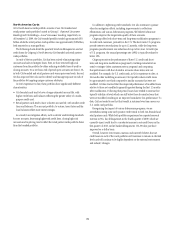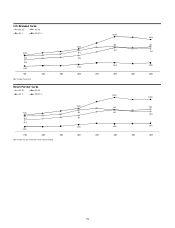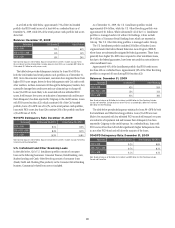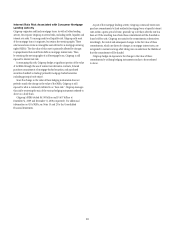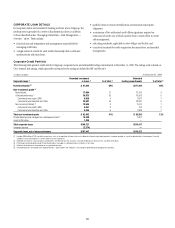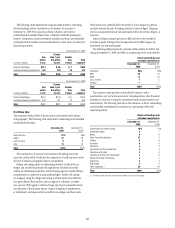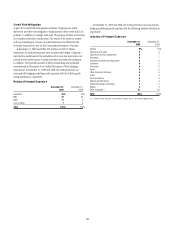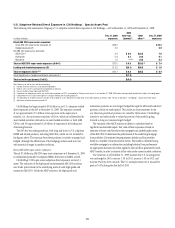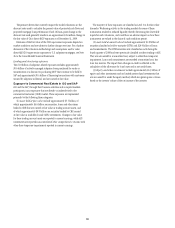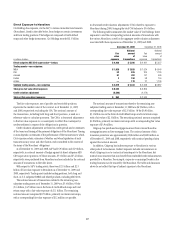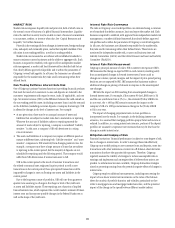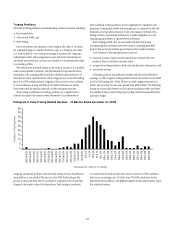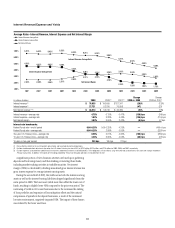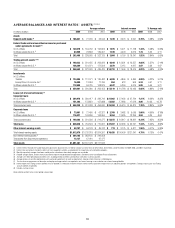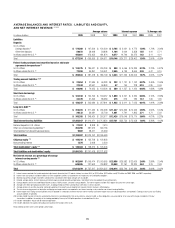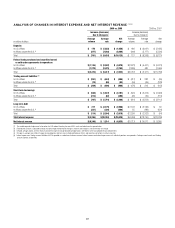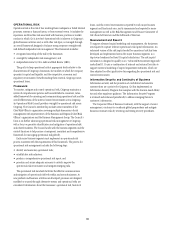Citibank 2009 Annual Report Download - page 98
Download and view the complete annual report
Please find page 98 of the 2009 Citibank annual report below. You can navigate through the pages in the report by either clicking on the pages listed below, or by using the keyword search tool below to find specific information within the annual report.88
Highly Leveraged Financing Transactions
Highly leveraged financing commitments are agreements that provide
funding to a borrower with higher levels of debt (measured by the ratio of
debt capital to equity capital of the borrower) than is generally the case
for other companies. In recent years through mid-2008, highly leveraged
financing had been commonly employed in corporate acquisitions,
management buy-outs and similar transactions.
In these financings, debt service (that is, principal and interest payments)
absorbs a significant portion of the cash flows generated by the borrower’s
business. Consequently, the risk that the borrower may not be able to meet
its debt obligations is greater. Due to this risk, the interest rates and fees
charged for this type of financing are generally higher than for other types of
financing.
Prior to funding, highly leveraged financing commitments are assessed
for impairment and losses are recorded when they are probable and
reasonably estimable. For the portion of loan commitments that relates to
loans that will be held for investment, loss estimates are made based on the
borrower’s ability to repay the facility according to its contractual terms. For
the portion of loan commitments that relates to loans that will be held-for-
sale, loss estimates are made in reference to current conditions in the resale
market (both interest rate risk and credit risk are considered in the estimate).
Loan origination, commitment, underwriting and other fees are netted
against any recorded losses.
Citigroup generally manages the risk associated with highly leveraged
financings it has entered into by seeking to sell a majority of its exposures
to the market prior to or shortly after funding. In certain cases, all or a
portion of a highly leveraged financing to be retained is hedged with credit
derivatives or other hedging instruments. Thus, when a highly leveraged
financing is funded, Citigroup records the resulting loan as follows:
the portion that Citigroup will seek to sell is recorded as a loan held-for-•
sale in Other assets on the Consolidated Balance Sheet, and measured at
the lower of cost or market; and
the portion that will be retained is recorded as a loan held-for-investment •
in Loans and measured at amortized cost less a reserve for loan losses.
Due to the dislocation of the credit markets and the reduced market
interest in higher-risk/higher-yield instruments since the latter half of 2007,
liquidity in the market for highly leveraged financings has been limited. This
has resulted in Citi’s recording pretax write-downs on funded and unfunded
highly leveraged finance exposures of $521 million in 2009 and $4.9 billion
in 2008.
Citigroup’s exposures to highly leveraged financing commitments
totaled $5.0 billion at December 31, 2009 ($4.7 billion funded and
$0.3 billion in unfunded commitments), reflecting a decrease of $5 billion
from December 31, 2008.
In 2008, Citigroup completed the transfer of approximately $12.0 billion
of loans to third parties, of which $8.5 billion relates to highly leveraged loan
commitments. In these transactions, the third parties purchased subordinate
interests backed by the transferred loans. These subordinate interests absorb
first loss on the transferred loans and provide the third parties with control of
the loans. Citigroup retained senior debt securities backed by the transferred
loans. These transactions were accounted for as sales of the transferred loans.
The loans were removed from the balance sheet and the retained securities
are classified as AFS securities on Citi’s Consolidated Balance Sheet.
In addition, Citigroup purchased protection on the senior debt securities
from the third-party subordinate interest holders via total return swaps
(TRS). The counterparty credit risk in the TRS is protected through
margin agreements that provide for both initial margin and additional
margin at specified triggers. Due to the initial cash margin received, the
existing margin requirements on the TRS, and the substantive subordinate
investments made by third parties, Citi believes that the transactions largely
mitigate Citi’s risk related to the transferred loans.
Citigroup’s sole remaining exposure to the transferred loans are the
senior debt securities, which have an amortized cost basis and fair value of
$7.0 billion at December 31, 2009. The change in the value of the retained
senior debt securities that are classified as AFS securities are recorded in AOCI
as they are deemed temporary. The offsetting change in the TRS are recorded
as cash flow hedges within AOCI. See Notes 16 and 22 to the Consolidated
Financial Statements for additional information.


